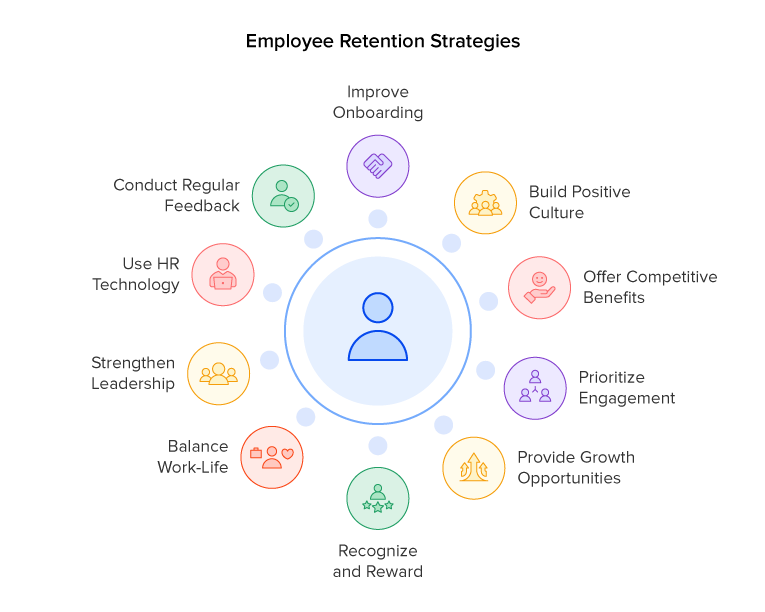10 Effective Employee Retention Strategies 2025

Table of Contents
In the modern working environment, keeping employees with great qualifications is extremely challenging, with the average turnover standing at around 5% in 2025. Since high turnover means frequent recruitment, it costs the company resources and hinders teamwork and overall productivity.
This is why companies are now expected to develop schemes and plans that concentrate on promoting employment longevity through compensation, appreciation, and career progress.
Our analysis in this blog will present the ten most effective employee retention strategies that organizations can follow to improve retention and build committed employees who stay with the organization. We will then demonstrate approaches to maintain your talent’s engagement and loyalty.
What is Employee Retention?
Employee retention refers to an organization’s ability to retain employees over time while reducing turnover rates. In today’s fierce competition, any organization that wants to sustain a team of skillful workers must have a solid focus on retention.
Employee retention is crucial for businesses to maintain a steady skilled talent pool while also recruiting new staff members in today’s competitive industry. Businesses that implement strong retention strategies achieve two benefits: higher productivity and better team performance, which results in stable organizational operations over time.
Employee retention depends on an organization’s ability to enhance employees’ worth and professional motivation. Companies must incorporate an open communication policy to validate their employees. This means that when employees see their contributions making a difference for their team and organization, it will become easier for them to stay with the team and the organization.
Thus, companies can have a committed and loyal staff by paying attention to these small aspects. The following sections will explore fundamental approaches to help organizations improve employee retention and build a highly productive and dedicated workforce.

Why are Workers Leaving?
Understanding why employees choose to leave the organization helps enhance employee retention. An exit interview allows the departing employee to describe and share their experiences, as well as identify common elements in their decision-making process.
Employee retention is primarily driven by psychological needs, such as fair treatment and job security, rather than just compensation. According to a Korn Ferry survey, 82% of respondents indicated they would switch jobs for improved pay or benefits.
The Boston Consulting Group’s survey shows that appreciation matters more than financial compensation because it enhances the employee’s sense of belongingness, increasing their commitment to stay. Employees often opt to leave their jobs due to several key factors that influence their decisions. Here are some key factors that impact employee retention:
- Job Dissatisfaction
- Lack of Career Advancement
- Less salary
- Boredom
- The desire to make a change
- Burnout
- Poor Work-Life Balance
- Unsupportive Working Environment
- Lack of recognition

Top 10 Effective Employee Retention Strategies
When employees leave frequently, business operations are disrupted, and organizational progress slows down. This, in turn, costs more money, and organizations might lose important expertise. During such a crisis, employee retention strategies that successfully retain employees represent a vital solution to combat this problem. This list presents ten strategic methods to boost employee retention, helping businesses retain their top employees.

Improve Onboarding and Training Programs
Organizations that establish organized onboarding systems enable new workers to grasp their responsibilities, learn about company culture, and develop relationships with colleagues. Following the initial week, ongoing educational programs remain essential to help workers develop the skills necessary for performance excellence.
Build a Positive Work Culture
An encouraging and uplifting workplace built on a solid foundation ensures employee retention. In this manner, an inclusive, respectful, and transparent culture will enable employees to connect with their work. Promote initiatives that strengthen workplace relationships, encourage teamwork, and promote trust among employees. This would create adaptability in the workplace, help overcome responsiveness issues, and foster great alignment between organizations and employees. Explore the agile HR glossary to gain valuable insights on fostering a positive culture.
Offer Competitive Payment and Benefits
Employees will stay with the organization, which offers fair salaries and a comprehensive benefits package. Employers regularly revise salaries to keep packages current, taking into account DEI considerations. A salary should be complemented by an excellent benefits package that extends beyond regular health coverage to include wellness initiatives, retirement savings, and additional perks. Employee compensation and benefits are key parts of payroll for any organization. They demonstrate that the organization values its employees’ contributions.
Prioritize Employee Engagement
An engaged workforce is necessary since satisfied employees produce better results and increased productivity. Organizations must establish multiple platforms for workers to offer feedback, receive acknowledgment, and conduct open discussions to achieve this.
This approach will motivate staff to communicate their thoughts and issues openly. Every organization should conduct continuous surveys to gauge employee opinions, as they provide essential insights for strategic improvements. Using this method will create a team that is dedicated and motivated.
Provide Career Growth Opportunities
Employee promotions tend to generate stronger company loyalty among their workforce. This loyalty becomes even stronger when companies provide relevant guidance that matches their professional objectives. In short, the presence of clear career advancement opportunities makes workers more likely to stay within the company for a longer period. As a result, this allows organizations to succeed over time because of workers’ strong commitment.
Recognizing and Rewarding the Work of Employees
Factors such as acknowledgment and appreciation drive employee motivation, which in turn helps organizations retain their personnel. An effective strategy to enhance motivation involves implementing a business-wide recognition system that acknowledges individual staff members and their work groups.
The rewards may include cash prizes, team-wide acknowledgements during meetings, or any other types of recognition. Ultimately, this culture of appreciation unquestionably fortifies an employee’s resolve to stay in the organization.
Work-Life Equillibirium
In the current work environment, striking a proper balance between work and life is necessary, as it makes employees feel better and more productive at work. To achieve that balance, companies need to offer flexible working hours and allow work to be conducted remotely. It is also important to set clear lines between the two worlds so that work communication does not encroach on private time.
These steps can make employees happy and increase their loyalty to their employer, resulting in improved employee retention. Finally, by emphasizing work-life balance, the organization will be able to create a better workplace culture. It will lose fewer employees, thus increasing the cost-benefit ratio for everyone involved.
Build Strong Leadership and Management
Training programs should incorporate key leadership skills, such as effective communication, empathy, and conflict resolution. The quality of leadership is vital, as it has a significant impact on employee retention and the overall success of the company. To achieve this, HRs should understand their team members and actively discuss their obstacles and professional goals with them. Developing an understanding between HR and their workforce produces an environment that enhances staff satisfaction and dedication.
A workplace built on integrity and reliability fosters a healthy working culture where managers motivate their employees to execute tasks in an environment where they feel valued and appreciated.
Use HR Technology for Better Retention
Modern technology allows staff members to provide feedback conveniently, enhancing team communication and employee retention. A positive workplace enhances staff satisfaction and promotes employee engagement. Organizations can also invest in tools like HR software, which help measure employee attrition.
Organizations can also implement softwares to gather combined employee feedback coupled with meaningful recognition and performance tracking methods for staff members. Companies can also use an integrated HR Software for better outcomes.
Conduct Regular Employee Feedback.
Regularly gathering employee feedback reveals organizational weaknesses and demonstrates that their opinions are valued within the company. A feedback loop must be established so employees can freely voice their thoughts and experiences. The company must conduct surveys and focus groups to demonstrate the impact that employee input has on changes. Such practices help create transparent working environments, which enable the company to strengthen its workforce.

Why Employee Retention Matters?
The emerging trend of job changes no longer carries a negative stigma, thus causing HR professionals to focus more on employee retention strategies. The shifting perspective regarding job transitions also encourages HR professionals to concentrate on workforce retention. Businesses need to understand the importance of employee retention because excessive employee departures will harm the organization’s operational aspects.
Cost of Turnover
Hiring new employees can be expensive. The cost of recruiting and training new staff can be three to four times the salary of the employee being replaced. According to the Society for Human Resource Management, the average expenditure on new employee acquisition is $4,700. The high cost of hiring new employees demonstrates why organizations must focus on staff retention, which eliminates the need for continuous hiring expenses.
Impact on Morale
High rates of employee turnover generate organizational instability, which makes employees doubt their security and leads to more staff departures. A strong employee retention strategy enables organizations to develop professional growth strategies with stable work environments and build positive company morale.
Effect on Productivity
The departure of employees creates additional work responsibilities for those who stay behind, which can lead to stress buildup and a decline in performance. Project delays often occur due to employee turnover, making it difficult for the organization to maintain consistent operations.
Threat to Output
Employee turnover patterns negatively impact a company’s ability to make products and deliver services. When key professionals leave the organization, they decrease its operational performance and decision-making capabilities, which in turn affects business output.
Customer Experience
Due to high turnover rates, team members who are unsatisfied or preoccupied often deliver substandard service quality, which harms customer satisfaction.

Conclusion
All the above employee retention practices serve as retention strategies, helping organizations create an enriching workplace that supports talent development and recruitment success.
Retaining employees proves vital in modern business competition because it directly affects productivity levels and team morale. An appealing solution like factoHR would deliver substantial advantages that help organizations better sustain their workforce.
This award-winning platform recognizes all employee activities to build a talent-friendly environment. Thus, the employee retention process becomes simpler through the use of factoHR. Establish the factoHR core HR module in your company to reach new heights in employee retention management.
1. What do Turnover and Attrition Mean?
Attrition and turnover depend on the circumstances of employee departures. A redundant employee is classified as attrition, and a departing employee is classified as turnover.
2. why Should all Organizations Focus on Employee Retention?
Internal recruitment offers excellent benefits to the company, as it reduces hiring costs and boosts the morale and productivity of employees, ultimately leading to increased customer loyalty.
3. how does One Calculate Turnover?
To calculate the turnover rate, HRs divide the total number of departing workers by the average employee headcount during this period and multiply this value by 100 to get a percentage result.
4. What does a Low Attrition Rate Mean?
A low attrition rate, such as 10% or below, indicates that the company has high retention rates and employees are generally satisfied with their jobs.
Grow your business with factoHR today
Focus on the significant decision-making tasks, transfer all your common repetitive HR tasks to factoHR and see the things falling into their place.

© 2025 Copyright factoHR


